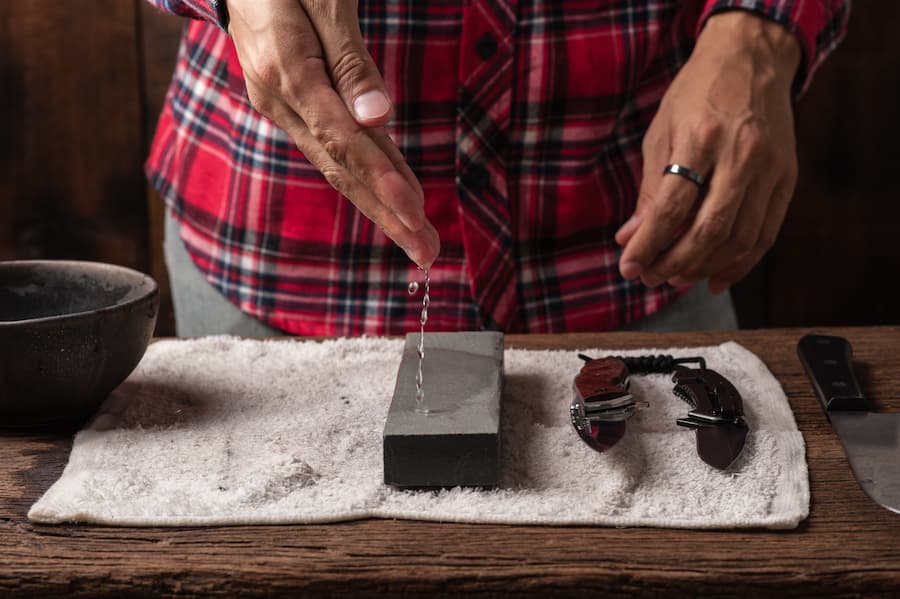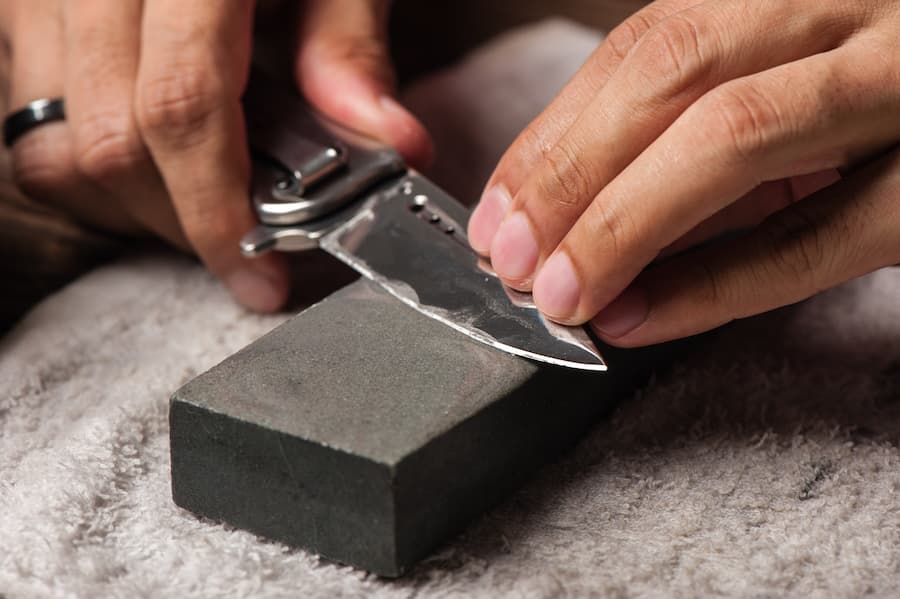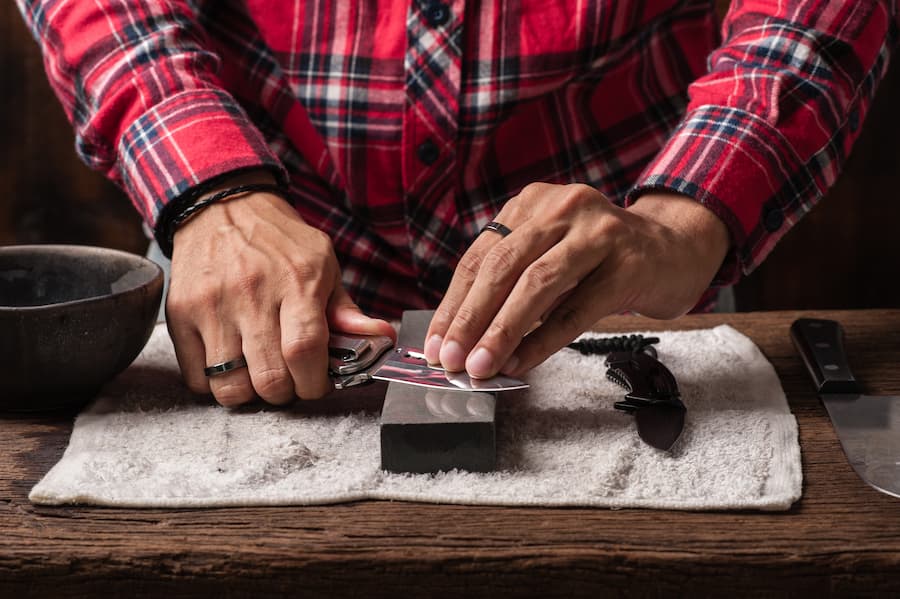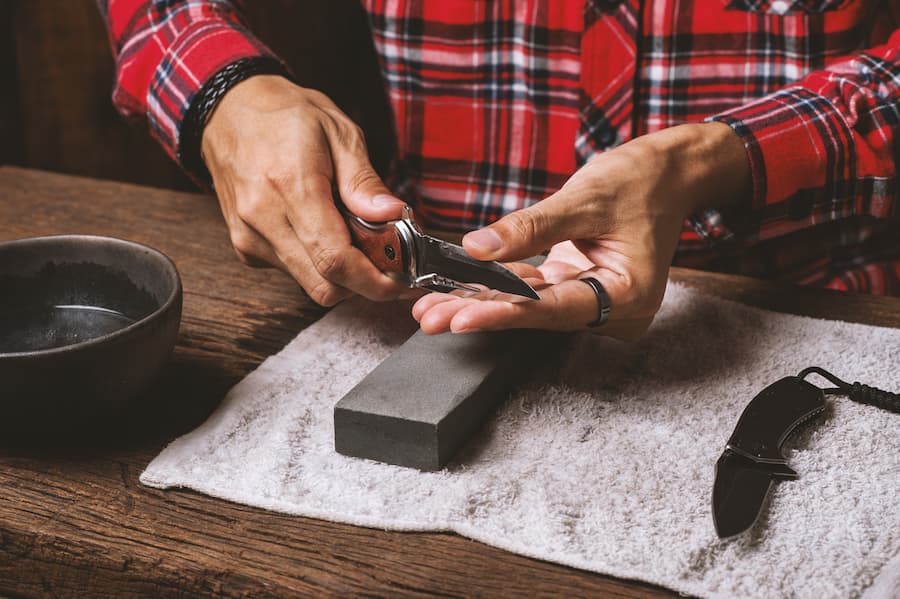How to Sharpen a Knife with a Stone
Mastering the art of knife sharpening is an essential skill for anyone who values quality tools, from outdoor enthusiasts to home cooks. A sharp knife enhances performance and ensures your blades' safety and longevity. While the process may seem daunting at first, with the proper guidance and practice, anyone can achieve a razor-sharp edge using a sharpening stone.
This guide will walk you through the fundamentals of knife sharpening, covering everything from choosing the suitable stone to mastering the technique. Whether you're preparing for a wilderness adventure, honing your culinary skills, or simply looking to maintain your everyday carry knife, these tips and tricks will help you keep your blades in top condition. Let's dive into the world of knife sharpening and unlock the potential of your cutting tools.
- Why Invest in a Whetstone?
- Choose the Right Sharpening Stone for Your Knife
- How to Tell if Your Sharpening Stone Uses Oil or Water
- Preparing Your Stone and Knife for Sharpening
- Proper Way to Sharpen a Knife with a Stone
- What Side of the Sharpening Stone to Use First
- Tips for Maintaining a Sharp Knife Outdoors
- Why a Sharp Knife Matters for Your Outdoor Pursuits
- How to Sharpen Your Fish Filleting Knife
- Reasons to Keep Your Blade Sharp
Why Invest in a Whetstone?
A whetstone is the go-to tool for precise knife sharpening. It offers superior control over the sharpening process, allowing you to achieve the perfect edge for your outdoor needs. While the initial cost might be higher than other methods, a quality whetstone is a long-term investment that will serve you well on countless camping trips and hiking expeditions.
Choose the Right Sharpening Stone for Your Knife
Your knife's material determines the ideal sharpening stone:
- For stainless steel knives, use a ceramic or diamond sharpening stone.
- For carbon steel or high-carbon steel, use an oilstone or a Waterstone.
Ceramic stones are known for their durability and ability to sharpen stainless steel blades effectively. They offer a smooth and precise sharpening surface.
Oilstones are made of natural materials like Aluminum Oxide and require oil as a lubricant. They provide a good balance of sharpening speed and control.
Waterstones, on the other hand, are made of abrasive particles bonded with clay or resin and require water as a lubricant. They offer various grit options, making them suitable for coarse and fine sharpening.
How to Tell if Your Sharpening Stone Uses Oil or Water
The color and texture of the stone can provide clues to determining whether it requires oil or water. Oilstones tend to be darker in color and have a denser texture, while Waterstones are lighter in color and have a softer, more porous texture.
Preparing Your Stone and Knife for Sharpening
To ensure a successful sharpening process, it is essential to properly prepare both your sharpening stone and your knife.
Start with a clean stone and a clean knife. Make sure the stone is clean and free of debris or residue. Use a brush or cloth to remove any dirt or particles from the surface. Do the same with the knife to ensure a smooth and effective sharpening process.
Soak or lubricate your sharpening stone. If you have a Waterstone, soak it for 10-15 minutes before using it. If you have an oilstone, apply a small amount of oil to the surface and run to smooth it over. Providing lubrication while sharpening helps the sharpening process go smoothly.
Check the knife's condition. check for damage or issues, such as chips, cracks, or other signs of wear, that need to be addressed before sharpening.
Align the knife's edge. Use a honing guide or your hand to align the knife's edge for even sharpening. You want to maintain a consistent angle, or you could wear the knife unevenly.
By preparing the stone and knife before sharpening, you can ensure that you achieve the best results and prolong the life of your tools.
Proper Way to Sharpen a Knife with a Stone
The proper technique for sharpening a knife with a stone requires precision to achieve the desired result.

- Find the correct angle. Hold the knife with the blade facing away from you and place it on the stone at a consistent angle. The ideal angle will depend on the type of knife and personal preferences. Generally, a 20-degree angle is a good starting point for most knives.
- Begin sharping. Starting from the base of the blade, draw the knife across the stone in a smooth and controlled motion. Apply moderate pressure and maintain a steady pace. Make sure to maintain the same angle throughout the sharpening process.
- Alternate sides. After a few strokes on one side, switch to the other side of the blade. This will ensure even sharpening and prevent one side from becoming more polished than the other.
- Use the entire stone. Move the knife along the full length of the stone, from the base to the tip, to ensure even sharpening. This will help maintain the proper curvature of the blade and prevent any uneven wear.
- Test for sharpness. After several strokes on each side, test the sharpness of the blade by gently running your thumb or finger across the edge. You have achieved a sharp edge if it feels smooth and effortlessly cuts through paper or food.



Remember, patience is key. Maintain a consistent angle and use smooth and controlled motions. Take your time to achieve that razor-sharp edge that will serve you well on your wilderness treks.
What Side of the Sharpening Stone to Use First
A sharpening stone typically has two sides. One is coarse, and one is fine. You should use the coarse side first for sharpening, then use the fine side for polishing.
Tips for Maintaining a Sharp Knife Outdoors
Keeping your knife sharp is essential for optimal performance during outdoor activities. Here are some tips to help you maintain the sharpness of your knife in the outdoors.
- Clean and dry your knife after each use. Outdoor environments can expose your knife to dirt, moisture, and other elements that can dull the blade. After using your knife, clean it with soap and water, making sure to remove any debris or residue. Dry it thoroughly to prevent rusting.
- Store your knife properly. Avoid storing your knife in damp or humid environments. Instead, keep it in a dry place, preferably in a sheath or protective cover. This will prevent moisture from accumulating and damaging the blade.
- Avoid cutting hard surfaces. While using your knife for tasks like opening cans or prying objects may be tempting, these actions can dull the blade. Limit your knife's use to cutting tasks only, and avoid using it on hard surfaces like metal or stone.
- Use a cutting board. Always use a cutting board when preparing food outdoors instead of cutting directly on rough surfaces. This will protect the edge of your knife and prevent unnecessary dulling.
- Sharpen it regularly. Even with proper care, your knife will eventually lose its sharpness. Regularly sharpening your knife with a stone or other sharpening tool will maintain its performance. Follow the proper technique for best results.
Why a Sharp Knife Matters for Your Outdoor Pursuits
A well-maintained, sharp knife offers numerous benefits for your wilderness activities, whether it's a hunting knife, a pocket knife, or a kitchen knife:
- Ensures clean cuts when preparing food or gear
- Improves efficiency and precision in various outdoor tasks
- Enhances safety by requiring less force to use
- Extends the lifespan of your valuable outdoor equipment
- Increases versatility for a wide range of camping and hiking needs
How to Sharpen Your Fish Filleting Knife
Sharpening your fillet knife is a simple process that can greatly improve its performance and extend its lifespan. Follow these steps to keep your fish fillet knife razor-sharp.
- Gather your materials. Before you begin, make sure you have all the necessary tools. You will need a sharpening stone, water, a damp cloth, and a stable work surface.
- Wet the stone. Soak the stone for 10 minutes before sharpening.
- Position the knife. Hold the knife firmly in one hand, ensuring a secure grip. Position the blade edge against the stone at a 20-degree angle. This is the optimal angle for a fish fillet knife.
- Sharpen. Using light pressure, draw the blade across the stone in a sweeping motion, moving from the base of the blade to the tip. Maintain a consistent angle throughout the process, and repeat this motion for both sides of the blade.
- Check the sharpness. After a few passes on each side, check the sharpness of the blade. Gently run your finger along the edge to feel for any rough spots or nicks. If needed, continue sharpening until the blade feels smooth and sharp.
- Clean and store. Once you're satisfied with the sharpness of your blade, clean off any debris from the sharpening process with a damp cloth. Dry the knife thoroughly before storing it in a safe place.
Reasons to Keep Your Blade Sharp
Keeping your blade sharp is essential for a variety of reasons. Here are some compelling reasons to ensure your blade is always sharp:
- Efficiency: a sharp blade easily cuts through materials, saving you time and effort.
- Precision: a sharp blade provides more control and accuracy.
- Safety: a sharp blade requires less force to cut, reducing the chances of slipping and accidental injury.
- Longevity: regular sharpening keeps nicks and chips from allowing further damage extending the life of the blade.
- Versatility: a sharp blade can handle a wide range of tasks, such as slicing, chopping, and carving.
By investing time in mastering knife sharpening techniques, you're not only improving your outdoor skills but also ensuring that your gear performs at its best for years to come. This dedication to quality and performance aligns perfectly with your approach to outdoor adventures, allowing you to focus on what matters most -- enjoying nature and pushing your limits in the wilderness.





